Menu
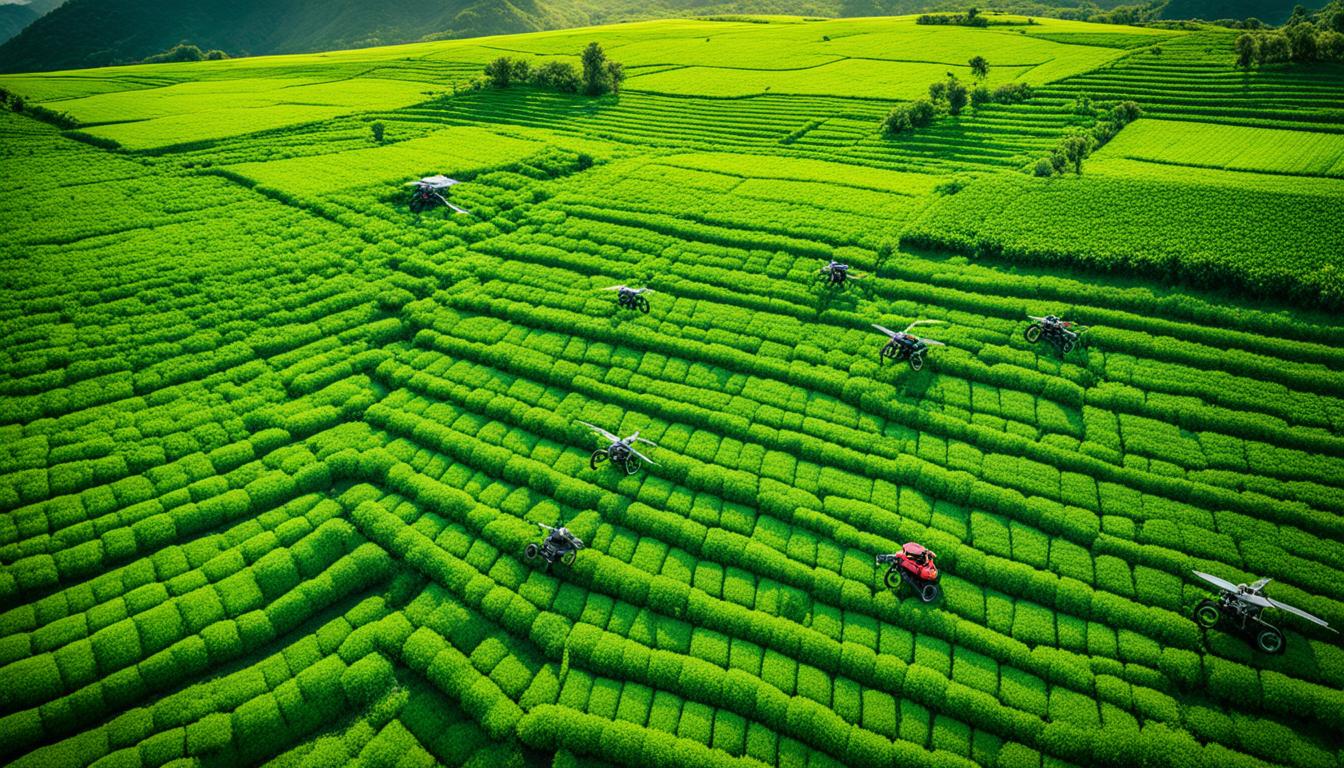
Do you know the U.S. Department of Agriculture says no one digital tool is widely used on farms? This means there’s a big gap between what digital tech can do and what farmers are actually doing. John Deere notes that by 2022, 330 million acres globally are using digital tools. Yet, getting everyone to use these tools is hard. This shows a change happening in farming. We’re seeing old and new ways mix together.
Farming today is at a turning point. It’s moving from the old to the new. Farmers are blending what they know with the latest tech. They’re using things like self-driving machines, GPS, and big data. But, they’re not using all the available tech yet. This mix of old and new is becoming more common.
Using digital tools in farming is more than just getting new toys. It’s about meeting big challenges head-on. Like, using less and being ready for the effects of climate change. This journey is tough, facing issues like high costs and tricky tech. But, the hope of doing more with less and being kinder to the planet drives it. Farming is aiming to unite high-tech and tradition wisely.
Recently, digital technology has made its mark in farming. It has introduced smart solutions and tech-based practices. Now, the farm landscape is changing for the better.
This change focuses on doing things more efficiently, sustainably, and accurately. It’s not only because of new technology. The need to deal with higher costs and protect the environment plays a big part too.
In the past, farming relied heavily on old ways and hard work. But in the last few decades, there have been big steps forward. Now, IoT, sensors, and tools for precision farming are here.
These new tools let farmers look at lots of data. They can now predict the best time to harvest and spot crop problems early.
Digital farming is growing fast for a few reasons. Firstly, it helps manage resources better. IoT devices and sensors allow precise control of water, nutrients, and pest control. This helps crops grow better with less waste.
Also, farming drones with AI can fine-tune how fertilisers and water are used. This makes farming more efficient.
Secondly, digital farming is good for the planet. It cuts back on harmful chemicals, keeping the soil and wildlife safe. Plus, sensors and monitoring let farmers keep a close eye on their animals’ health and behaviour.
Using digital tech in farming isn’t easy. Many farmers, especially smaller ones, find it too expensive. They also worry about the complexity and if it’s worth the cost.
It’s also wrong to believe one gadget can fix all farming problems. A mix of different digital farming methods is the real answer.
Below is a look at what drives or blocks the use of digital farming:
| Driving Factors | Challenges |
|---|---|
| Optimisation of resource management | High equipment costs |
| Environmental sustainability | Complexity of technology |
| Improved livestock management | Lack of immediate ROI |
To sum up, more and more digital tools are being used in farming. This shift means a future of farming that uses more data, is greener, and works better. This will change farming a lot, making it more productive and taking better care of our planet.
Digital farming solutions are changing agriculture for the better. They offer many benefits that farmers need today. These new tools make farming more efficient. They also help in using smart farming methods and ensuring farming is sustainable.
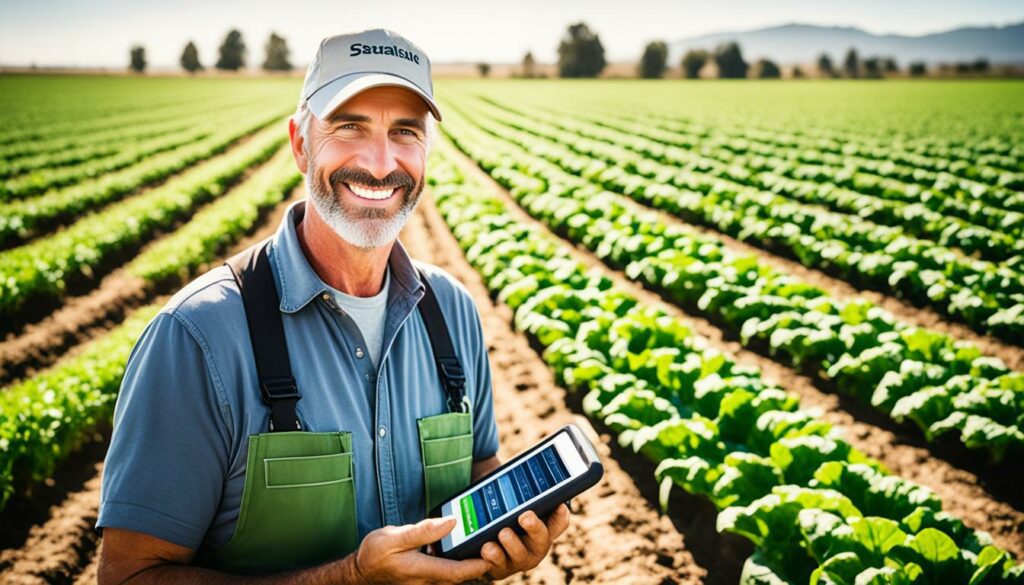
Digital farming boosts productivity a lot. The market for agricultural robotics is already over $5 billion. It’s set to double in five years. Modern tools like data analytics, remote sensing, and drones help farmers work better. They can check on crop health in real time. For instance, drones in China monitored 20 million hectares of cotton. This shows how digital tools can make farming more efficient on a large scale. Also, cloud technology gives farmers fast internet. This lets them make quick decisions to improve productivity further.
Digital farming promotes eco-friendly farming methods. As supply chains face challenges, companies are investing in digital upgrades. These upgrades use less fertiliser and water, being more sustainable. By using data for farming decisions, farmers waste fewer resources. They also learn how to use inputs like fertilisers and pesticides better. This is good for the planet and helps reduce the cost of farming.
Digital solutions help farmers manage resources better. They provide a lot of data for farmers to learn from. By using this data, farmers make smart decisions quickly. This boosts productivity and cuts costs. Greenhouse farming and orchard management use technology to control climate and analyse data. This helps farmers use resources more efficiently. Plus, tools like Agmatix and Nutrient Deficiency Guide support farmers in growing better crops and reducing waste.
Integrating modern farming with old ways is tricky. One big issue is the cost. Buying modern tools and keeping them up is expensive. This makes it hard for farmers to switch.
Using digital farm tech needs a lot of money. Things like IoT devices and sensors are not cheap. This cost can keep small farmers away from new farming methods.
New tools for farming can be hard to use. They are high-tech but need skill to operate. Farmers must learn how to use them. But, finding help isn’t always easy. So, sometimes these tools aren’t used well.
Getting quick profits from new tech is rare. It takes time to see the benefits. But, many farmers need fast results due to tight budgets. This stops them from investing in new technology.
Our goal should be to lower the cost and simplify tools. Making tech that is easy to use and shows value fast is key. By working together, we can make farming tech more affordable and useful. This will help mix old and new farming methods.
John Deere is leading in precision farming and modern farming methods. It has changed from just selling machines. Now, it’s breaking new ground in digital farming.

With yearly sales nearing $30 million and a market value of $48 billion, John Deere is a market leader. A major step was buying Blue River Technologies for $305 million in 2017. This buy showed their strong focus on digital tools for farming.
Technology innovation drives John Deere. Their San Francisco Labs are key for new software. Their tractors, using 4G LTE connections, process data instantly.
They use machine learning to improve all farming phases. This cuts down on herbicides and supports eco-friendly farming.
John Deere’s impact on the market is big, thanks to tech like Farmsight. John May, President of Agricultural Solutions, highlights tech importance. Even with concerns about repair policies, they stress on data safety and customer’s control.
John Deere is changing how Australian farms operate. Their digital tools offer real-time data and smart automation. This helps farmers, agronomists, and financial advisors work better together.
John Deere’s story shows how tech can transform agriculture for the better.
Robotics is key to moving farming forward. It improves on old farming ways and meets new challenges. One big reason farmers are using robots more is the growing need for food worldwide. They can farm more land and make fewer mistakes with help from GPS systems on autonomous tractors.
In many farming places, there aren’t enough skilled workers. Robots help here, making sure jobs get done well and on time. They use sensors and cameras for tasks like watering and fighting pests. This way, farms use less and produce more, thanks to these robots’ help.
Drones are also changing how we farm, by checking on crops from above. This makes it easier to act fast when crops need help, saving time and resources. Robots with special eyes can even pick fruit and veg right when they’re ready, meaning less waste. Still, these technologies can be too expensive for some smaller farms.
Using advanced robots can be tough for farmers not used to high-tech gear. It’s not always easy to fit these machines into every farm or crop type. Plus, some worry robots will take human jobs away, changing farm work in a big way.
| Statistic | Details |
|---|---|
| Projected Global Crop Demand Increase | 60% by 2050 (FAO) |
| Global Agricultural Robot Market Value | $43 billion in 2021, projected $81 billion by 2028 (AZO Robotics) |
| Water Reduction by Robots | Less than 90% of water usage for over 20 times the crop yield per acre |
| Impact on Labour Costs | 50% of labour costs are on the cost of growing farm; 55% of farmers impacted by labour shortage |
| Chemical Pesticides Reduction | 50% reduction by 2023 (European Commission) |
To sum up, robots in farming are vital for fighting climate change. They lower harmful emissions and let us use less chemicals. This is why robotics is seen as a game-changer in farming, making it more efficient and earth-friendly.
Precision agriculture is changing farming’s future with advanced tools and smart solutions. These tools help farmers enhance their work, cut costs, and boost crop production. It’s all about efficiency.
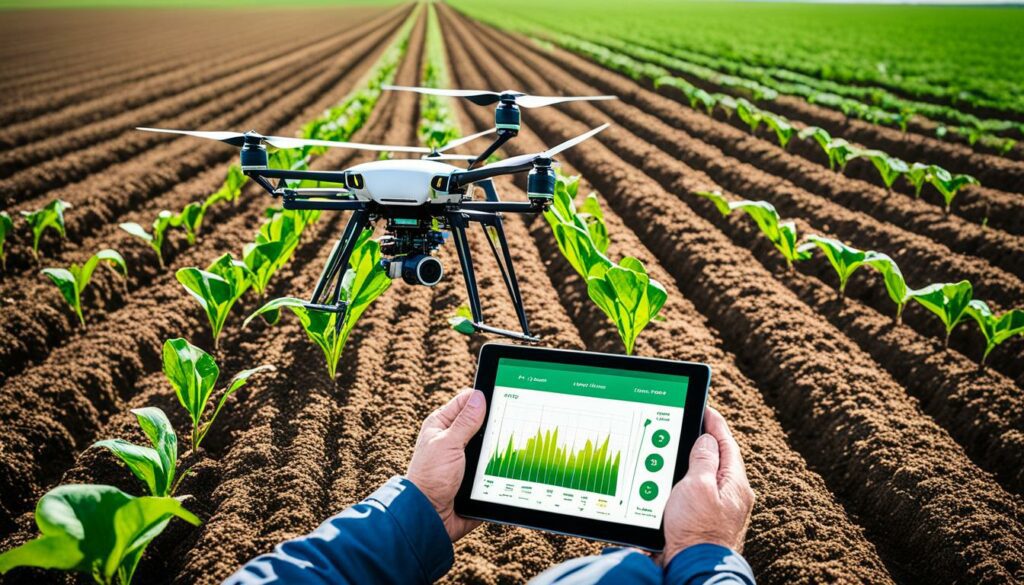
GPS tech in farm vehicles means they work with amazing precision. It cuts down on wasted resources and makes everything more efficient. Just by using RTK technology, the time needed to check the fields can drop from days to 30 minutes.
With RTK systems, farmers can quickly see how the initial costs are covered by higher efficiency and productivity.
Yield mapping is key for improving crops. It helps farmers spot which zones might need more seeds, fertiliser, or water. By adjusting these inputs, farms can get a 4% boost in production while using less fertiliser and fewer herbicides.
VRT (Variable Rate Technology) takes this further. It lets farmers change how much input they use, guided by detailed soil and yield data. This not only boosts yields but also cuts down on environmental impacts by using only what’s really needed.
Farmers can also get detailed soil data through high-tech imagery. This helps make decisions that are based on solid facts rather than guesses. It keeps crops healthy and the land fertile for the future.
Satellite images and remote sensors give real-time data on crops and soil. This helps farmers quickly find and solve issues, leading to better management. Precision agriculture uses big data and machine learning for practical and eco-friendly farming.
Using these high-tech tools and smart techniques is essential for the future of agriculture. It helps make the most of the soil, keeping it healthy for the next generations. This way, we can ensure a steady supply of food while looking after the planet.
| Metric | Improvement |
|---|---|
| Farmer’s Production | +4% |
| Fertilizer Use | -7% |
| Herbicide Applications | -9% |
| Fossil Fuel Use | -6% |
| Water Savings | +4% |
In India, fewer people work in agriculture now, and the land for farming is shrinking. So, using technology in farming is very important. Technology has changed how farming works. Digital tools are key to this change.
IoT devices and sensors have changed farming by collecting data in real-time. They check on things like moisture, temperature, and humidity in the soil. This helps farmers a lot. With technology, farmers can make better choices, use fewer resources, and make their farms more productive. This way of farming fine-tunes everything for the best results.
Looking after the health of animals and crops is very important. Digital tools help a lot with this. Sensors on animals watch things like temperature and heart rate to catch health problems early. The same goes for crops. Sensors in the fields spot issues early so farmers can act fast. IoT makes farming proactive. This approach boosts crop harvests and keeps animals well.
Using IoT in farming is not just a phase; it’s something we need for feeding the world. By 2030, the market for IoT in agriculture could be worth over USD 43.37 billion. The future of farming relies on digital tools. They will make farms more productive and strong.
Climate-smart agriculture technologies are gaining traction, particularly in developing countries, for improving food security, farm system resilience, and reducing greenhouse gas emissions.
| Parameter | Traditional Farming | Tech-Enabled Practices |
|---|---|---|
| Productivity | Low | Optimised through real-time data |
| Resource Management | Inefficient | Efficient with IoT sensors |
| Monitoring | Manual | Automated via digital solutions |
By 2050, our world will have nearly 10 billion people. This puts a big challenge on farming. But, Artificial Intelligence (AI) steps in to help. With its tools for predicting and using high-tech farming gear, AI is changing how we farm. It helps us grow more food while spending less. This shift is key for farming smartly and keeping our planet healthy.
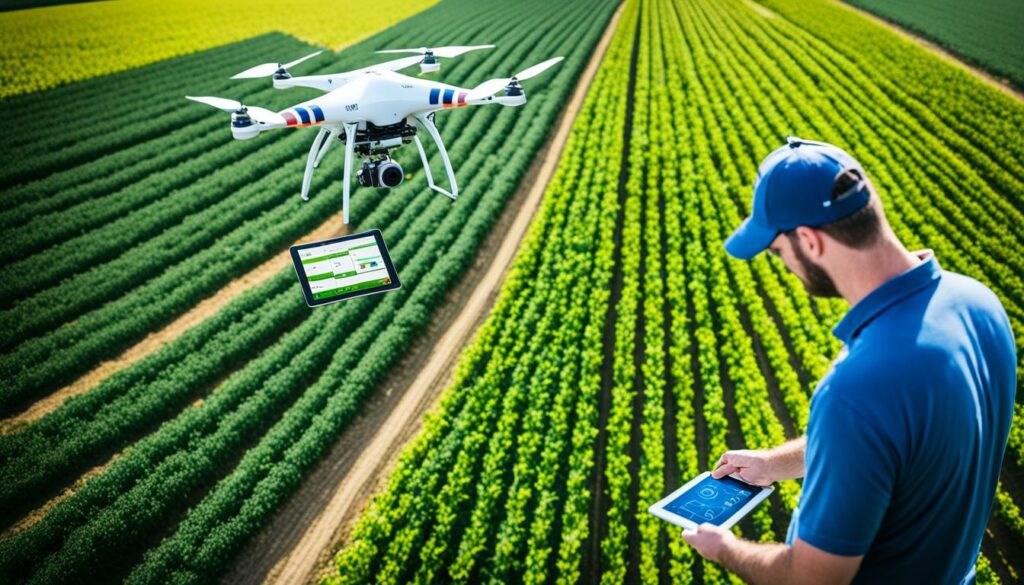
AI helps make farming choices smartly and on time because it predicts things. The use of AI in farming is expected to jump from USD 1.7 billion in 2023 to 4.7 billion by 2028. It looks at past data, weather, and soil to guess how much food we can grow. This better planning makes farming more efficient, helping farmers make more money.
AI really shines in making farming decisions better. It’s way better than just guessing. AI works with sensors to decide when to water or deal with bugs, helping the earth. Drones with AI can use less bug spray but still protect crops. And AI keeps an eye on animals, spotting when they’re sick or having babies. This makes farming smarter and more ready for surprises.
To sum up, AI is a game-changer for farming. From guessing well using data to making smart choices, AI is the farm tech of the future. As more farmers use AI, farming gets better. It’s all about feeding more people without harming the planet.
Drones are changing the way farmers work. They help by keeping an eye on fields, helping with watering, and planting crops accurately. These tools give farmers a lot of data and pictures to make better choices and take care of their crops well.
Unmanned aerial vehicles (UAVs) are really important for watching over fields from the sky. When a drone flies, it can take as many as 4000 pictures. These pictures are turned into detailed maps with software like Pix4D or Agisoft. The maps show things like the health of the crops, the soil, and if there are any pests.
The best part? Drones with special equipment can be super accurate, down to a centimetre. This means they can show exactly where things are. They’re also a lot cheaper to use than satellites or having people flying over in planes.
Drones are a big help with watering and planting. The DeltaQuad Evo drone can fly for a long time and carry special sensors that see different things. These drones can even work in bad weather, like when it’s raining or snowing, keeping up to date with up to 50km of land.
| Drone Model | Flight Duration | Special Features |
|---|---|---|
| DeltaQuad Evo | 4.5 hours | Heavier payloads (LiDAR, RGB, multispectral) |
| DeltaQuad Pro #MAP | 110 minutes | 61 MP RGB cameras, high-quality multispectral & thermal sensors |
Using these drones improves farming a lot. They help target the right areas for more water or better planting. Research shows that images from drones are more detailed and accurate than older ways of looking at fields. This helps farmers make smarter choices about how to manage their land.
The future looks bright for drones in farming, with a big market expected. By 2025, the market size for these high-tech farming tools is expected to reach $43.4 billion. This shows the important role drones play in making farming better, using resources wisely, and planning for a sustainable future.
The use of cloud connectivity is growing in farming, changing how agriculture works. With cloud computing, farmers can access digital tools that keep them connected in real-time. This is key for dealing with the fast-changing needs of farming today.
It means more data and better systems, leading to smarter ways of working and adapting to challenges. Farmers can work more efficiently and react faster to problems.
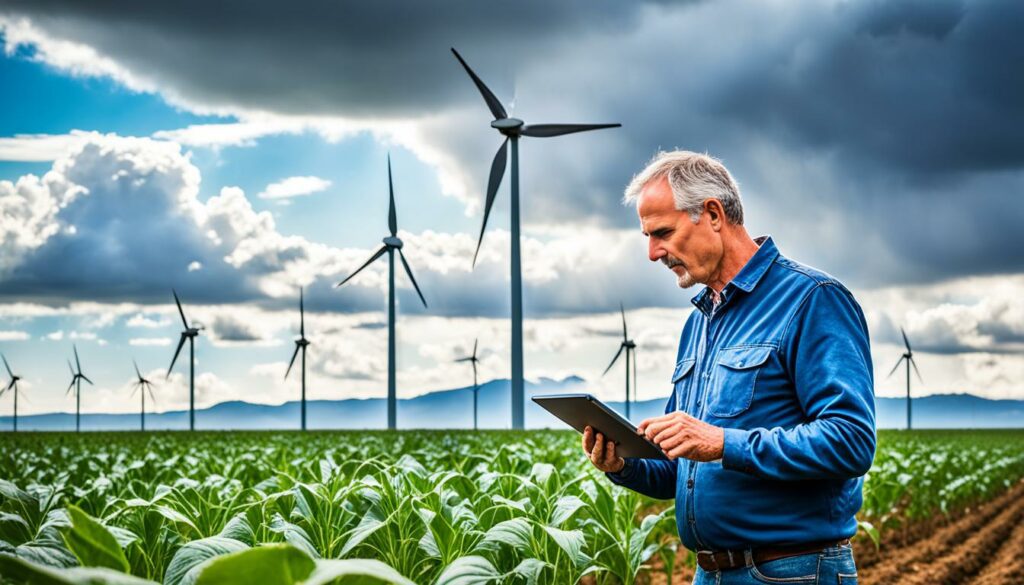
A recent study shows that by 2030, better connections in farming could make a $500 billion difference to the world’s economy. As our population grows to 9.7 billion by 2050, we’ll need 70% more food. This makes cloud connectivity very important for farming’s future.
Improved connections might boost the economy by $500 billion. This would mean a 7 to 9 percent increase in how much work the industry can do.
In the US, only around a quarter of farms use connected tech now. But by 2030, about 80% of the world’s rural places will have advanced digital connections. This huge change is all about preparing for the future by making farming more efficient and ready to deal with coming challenges.
Connected farming offers many benefits. It helps with watching crops and animals, keeping buildings and equipment in check, using drones for farming, and making machinery that can work on its own. Let’s explore how each area is changed:
| Category | Impact |
|---|---|
| Data Management & Analytics | Cloud computing makes it easy to collect and study a lot of data. It’s from sensors and drones. It helps with storing data well and making decisions based on facts. |
| Precision Agriculture | Using the cloud with special sensors and devices lets farmers check the soil and weather in real-time. This helps them make accurate choices about how and when to water, add fertiliser, or control pests. |
| Remote Monitoring & Automation | The cloud lets farmers check and control their operations from far away. It can make machines work better and more efficiently with automatic systems. |
| Collaborative Platforms | Cloud services help farmers, researchers, and experts work together. It’s good for sharing ideas and keeping up with what’s new in farming. |
| Weather Forecasting & Risk Management | The cloud can give up-to-date weather information and forecasts. This helps farmers plan better and be ready for surprises from the weather. |
| Supply Chain Optimization | The cloud makes the supply chain clearer and easier to follow. It lets different people involved in farming share data quickly. This helps everything run better. |
In the ever-changing world of agricultural technology, data analytics is key. It helps make smart decisions and sparks new ideas. With the help of large data, farmers can turn raw info into smart farming solutions. These solutions boost both productivity and eco-friendliness.
Precision agriculture uses data from many places, like satellites and sensors. This mix of information helps manage fields better for planting, fertilising, and harvesting. Big data in agriculture is great for spotting trends from large data sets. It helps with important advancements, such as genetic studies and understanding plant diseases.
Using predictive analytics, farmers can guess what future conditions might be. This helps with things like fighting pests, stopping diseases, and preparing for bad weather. By knowing what could go wrong, they can protect their crops better.
Good data analysis gives key insights into the best ways to grow crops. Technologies like remote sensing and drones help here. They mean farmers can use water better, look after the soil, and cut down on harmful chemicals. By looking at how resources are used and the environment, farmers can sustain their work for the future.
Data analytics are also crucial for making sure products get to where they’re needed. By handling shipping and guessing what choices customers will make, these tools cut waste and keep food fresh. Next-gen smart farming solutions can do things like watching over crops and give very detailed future predictions. They also push for the use of automatic farming tools.
But, there are hurdles. Making data easily available to all farmers and getting different data to work together can be tricky. Yet, as agricultural technology gets better, it will change how we make food. It will lead to cool stuff like farms that go up, not just out, and plants made to be better.
Combining digital and traditional farming creates a bright future. It merges the best of both worlds to boost farm efficiency and keep traditions alive. This approach is crucial for making agriculture more productive and sustainable, especially with the challenges of today’s world.
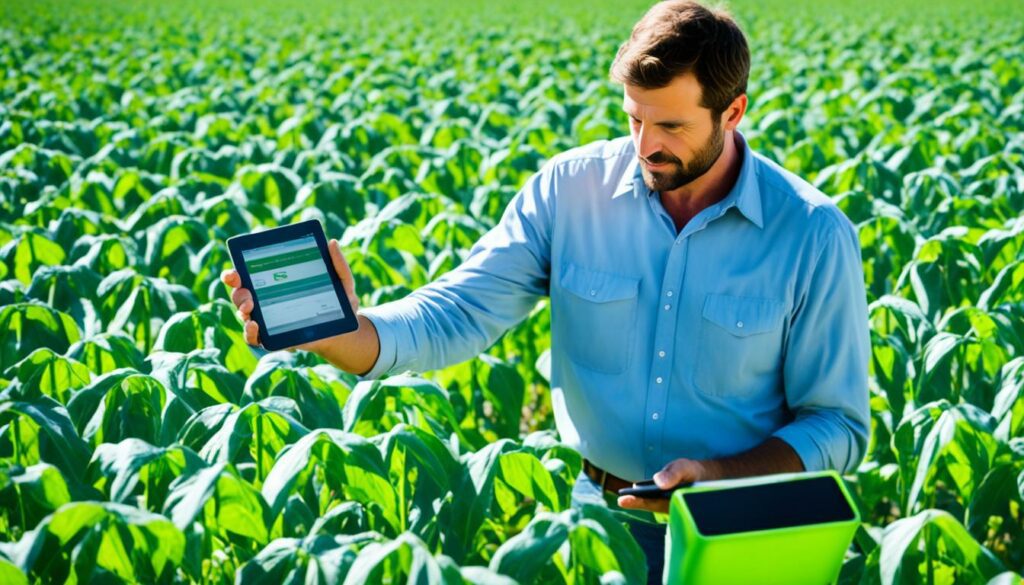
Using precision agriculture helps a lot. Farmers can make their crops even better by using the perfect amount of inputs. This reduces wastage and makes crop yields bigger. By using soil sensors and weather stations, farmers make smarter decisions about planting and managing crops.
Drones are also changing the game. They let farmers keep an eye on their crops from above, spotting any issues quickly. Drones can do tasks like planting and spraying more efficiently too. They work with Artificial Intelligence to do things like predict diseases in crops, which helps farmers plan better and reduce risks.
But, starting to use these new technologies can be tough. It costs a lot at first. Many farmers also need to learn new skills and might not be used to changing how they work. Yet, the many benefits of modern farming, from saving resources to cutting down on waste, are worth these challenges.
To make farming even better in the future, we need to keep innovating with AI, IoT, and blockchain. These new technologies promise to watch over farms in real time, make supply chains clearer, and introduce new farming methods. With the world growing and needing more food, blending tech into farming is key for the future.
Fully adopting hybrid farming isn’t easy, but it’s very important. By tackling the problems and embracing change, we can make farming more efficient and strong for the future.
In today’s fast-changing world, learning and practice are key in farming. They help cultivate a skilled team that can use new technology. This is important as farming methods incorporate more digital tools.
The UK’s average farmer is 59, and Japan’s is 67. There’s a call to bring in younger people to keep agriculture running. Using technology can draw young folks to farming, making it more attractive. It also improves farm work, boosting output by 8.7% with just four years of basic education.
Automating farming cuts down on harmful chemicals and grows more food. But, there’s a risk it could leave some farmers out of work. To avoid this, everyone needs proper training. For farmers in poorer countries, tech can be expensive. Teaching them cost-saving skills and with government help can keep them in the game.
Team-ups with schools push farming in new directions. For example, the Jiva demo improved harvests from 1.8 to 2.6 tonnes. It shows the power of working together. Engaging local young people and women in these projects boosts farming and the local economy.
Research in Sulawesi, Indonesia, found that young and female farmers like trying new things better than older men. Getting more women involved in producing food could reduce hunger by 45 million people worldwide.
Working with schools also helps in keeping data safe. Farming relies more on tech, which can be targeted by cyber attacks. Training farmers to protect these systems is crucial. It means they can use tech safely without worry.
| Country | Average Age of Farmers | Key Training Focus |
|---|---|---|
| UK | 59 | Sustainable Agriculture Practices |
| Japan | 67 | Data Security Measures |
| Developing Countries | Varies | Cost-Effective Technology Use |
Digital farming technology is key to sustainable agriculture. It changes how we work with the land. With smart farming tools, farmers can cut their impact on the environment. This move helps in creating a more eco-friendly farm.
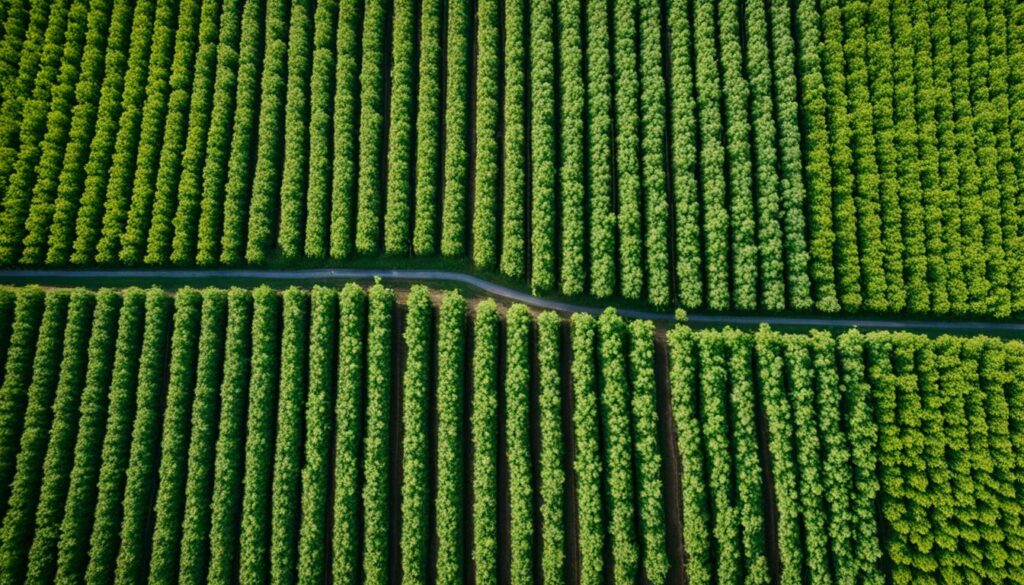
Precision farming tools like GPS and data analysis help use resources better. They ensure that things like water, fertilisers, and pesticides are only used when needed. This means less waste and less harm to our surroundings.
Farming has been slow to adopt digital tech. But, McKinsey experts say it’s ready for a change. They believe tools that offer real-time data can make a big difference. Farmers can adjust their irrigation and farming methods with more precision.
Drones make a big difference, especially in places like China. They help monitor the health of big crop areas. This improves how crops grow and cuts down on harm to nature.
Companies are putting more money into digital farming. They use tech like RFID and better wireless systems. This makes the farming supply chain work better. With tools like IoT and sensors, they learn more about the soil, weather, and plant health.
Thanks to the cloud, farmers can use digital tools in easier ways. This means they can act quickly with the latest info. It makes farming both more efficient and kinder to the planet. These changes support a more sustainable farming future.
| Technology | Environmental Impact |
|---|---|
| Precision Agriculture Tools | Reduced input usage and optimised resource management |
| Drones | Enhanced monitoring and conservation of crops |
| IoT and Sensors | Real-time data collection and informed decision-making |
Sustainable agriculture is linking more with digital innovations. These new technologies promise to make our food more secure. They tackle problems like a growing population, shifting climate, and limited resources.
Precision farming tools, the Internet of Things (IoT), and robots are changing how we farm. They help farms produce crops better, with less waste, and higher quality. Smart farming tech can do tasks like planting and harvesting on its own. This cuts down on the need for lots of human workers and makes farms more efficient.
Future digital tools will make farming even more efficient. AI and IoT will help farmers make smarter choices by using big data. This tech will let farmers keep a closer eye on their crops. This is vital for farming that’s good for the planet and can last long-term.
These new technologies aren’t just about making farming efficient. They’re also changing how we think about keeping food supplies safe. They encourage farming methods that use less resources like water and nutrients. Methods like vertical farming and hydroponics are doing more with less, and that’s better for the Earth.
Precision farming gives farmers better control over their crops. It makes sure we grow food in ways that don’t harm the planet. By using digital solutions, agriculture is moving towards a future where we can grow food well, without hurting the Earth – a future where food and agriculture are both productive and safe.
There are methods like Quality Function Deployment (QFD) helping with this change. They link new technologies to making farming better for the environment. This means the choices we make now are creating a path for a greener and more secure farming in the future.
In wrapping up, technology and sustainable farming are becoming more connected. With the right tech and methods, we can make sure there’s enough good food for everyone, while also taking care of our planet. The future we’re working towards is one where farming is both productive and good for the environment.
We’re creating a new way for farming by mixing tradition with digital tech. This approach aims to improve farms and protect the environment. It uses smart farming, which includes tools like AI to make farms more efficient.
These technologies help farmers use less and produce more. They can predict the weather, warn about pests, and check on plants very precisely. For example, Intel’s OpenVINO toolkit is a great help in this.
Using AI also means using fewer harmful chemicals. This keeps the environment safer and healthier. It’s crucial if we want to feed more people around the world without hurting our planet.
The digital farming market is growing fast, reaching $15 billion in 2021. Most businesses know that going digital helps them stay ahead. So, the push for these new farming methods is really strong.
But, not everyone can jump on this digital farming train just yet. Places without good internet or tech know-how are left behind. We need everyone, from governments to tech companies, to help out.
By giving all farmers access to the latest tech, we can make farming work better for everyone. This means even small farmers can be more competitive. And, with AI, we’re paving the way for better farming that can keep feeding us for years to come.
Digital technology is used alongside traditional farming to make it better. Things like IoT devices, special tools for farming precisely, and analysing data help a lot. They make farming more productive and good for the environment.
Digital tech in farming is growing because it helps save money, technology is getting better, and we want to farm in ways that are good for the Earth. Using smart farming and new tech helps farms be more productive and strong.
Digital solutions in farming mean making smarter choices with the help of data. This kind of farming doesn’t waste resources and keeps an eye on things in real time. It’s better for farming and less harmful to the planet.
Making digital and traditional farming work together can be expensive and complicated. People might not see the benefits right away, which can be hard. We need to make technology more affordable, easier to use, and show its value to farmers.
John Deere started using digital tools with their machines, moving from just making machinery to leading in smart farming. This change improves how they run their business and shows others the value of sustainable farming.
Modern farming relies a lot on robots now, not just for simple tasks but also for doing detailed jobs like weeding. This shows how robots are changing farming for the better.
Precision agriculture uses a lot of tools and skills, including GPS and keeping an eye on crop yields. These things make it possible to look very closely at fields. Then farmers can do exactly what each crop needs.
IoT devices and sensors take in real-time information that’s important for farming. They check on things like the weather and how plants and animals are doing. This information lets farmers be very exact in their decisions.
AI is a big help in farming because it can predict what’s best to do and make decisions faster. It does the job better than older ways, helping farming be more efficient.
Drones fly over fields to keep an eye on them, helping with things like watering and planting. They give farmers new perspectives on their land and crops.
Cloud systems make digital farming more flexible and quick to react to changes. They make it easier for farmers to use new information and technology. This helps farms run better and supports new farming methods.
Data analytics turn big sets of data into useful information. This is key for making smart decisions in farming, from managing crops to knowing what people will want to buy. It makes farming more true and advanced.
Using both digital and traditional farming together makes farming stronger and more ready to face challenges. It offers new ways of farming that work well and protect the planet.
Learning about new tech in farming is very important to have people who know what they’re doing. Schools and farms working together help to keep learning going. This supports using digital farming in ways that are good for the Earth.
Smart farming helps take care of the Earth by farming in very exact ways. This kind of farming uses less and is good for nature, helping farms last a long time.
Sustainable farming’s future is in new digital farming that’s also good for the planet. New tech and ways of farming will keep us fed and keep nature safe for tomorrow.